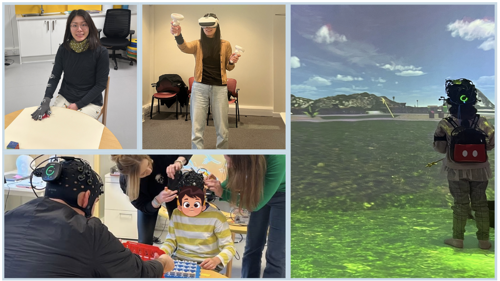
Early this year, I was lucky enough to receive the LuCiD travel grant to visit Birkbeck ToddlerLab hosted by Dr Ori Ossmy for 4 weeks. This journey has broadened my research vision and, importantly, taught me what being a research leader and a great mentor truly means.
Why Dr Ori Ossmy’s lab and why Birkbeck ToddlerLab?
I met Dr Ori Ossmy at the 2nd CBCD International Workshop on Naturalistic Experimentation of Child Development where he was the lead organiser. In the workshop, we learned the basic concepts of using time-series analysis to understand naturalistic behaviours, and I realised it was a skill I wanted to acquire further. During the workshop, I also visited Birkbeck ToddlerLab to see how researchers there implement the idea of naturalistic experimentation in various research topics. This experience motivated me to contact Ori for a lab visit to learn more about the naturalistic research of child development and time-series analysis.
What is naturalistic research?
Imagine the following scenario: A 7-month-old baby playing with a set of toy animals with their mother. When the baby picked up a dog, the mother simultaneously said, “A dog! Woof! Woof!”. The baby then quickly lost interest in the toys. The mother tried to keep the baby focused by introducing a new toy and said, “Look! A cow! Moo! Moo!”. The baby grabbed the cow and put it into her mouth. The mother then held and put the baby in a highchair and went to the kitchen…
This is a scenario that happens naturally in everyday life. Naturalistic research involves observing and studying children’s behaviours and developmental processes as they occur naturally in real-world settings. Compared to lab-based research, naturalistic research captures the complexity of natural behaviours and increases the ecological validity of the research (i.e., how well lab-based results can be generalised to real life).
How may time-series analysis help us understand children’s behaviour and language development in naturalistic settings?
Behaviours in naturalistic settings often contain a rich and complex source of information. Time-series analysis provides powerful tools to decompose this complexity and allows us to identify patterns, trends, and predictions from naturalistic data to gain insights into the developmental process.
For example, the above scenario contains two ‘timelines’ (i.e., time series) of natural behaviours – one from the baby and the other from the mother. By aligning the baby and the mother’s behaviours at each time point of the interaction and using time-series analysis methods, we can break down and understand the intricacy of the baby-mother interaction. For instance, we can investigate how well the mother’s labels aligned with the baby’s toy handling, and whether this alignment predicts the baby’s language development. We can also examine whether the baby’s attention was heightened before, during, and after they learned about the animal they chose themselves (e.g., dog), compared to the animals the mother chose for them (e.g., cow), and importantly, whether this difference leads to learning enhancement.
The good labs with cutting-edge research!
Apart from regular meetings with Ori that focused on my visit objectives of naturalistic research and time-series analysis, I was also actively involved in lab meetings and seminars as well as participating in and observing different ongoing projects in Ori’s lab and the ToddlerLab. During the four-week visit, I was amazed by the brilliant researchers and their various adventurous projects fully involving cutting-edge technologies! From combining fNIRS with motion tracking to hyper-scanning, researchers in Ori’s group and the ToddlerLab innovatively utilise these tools to investigate important topics in developmental science such as adaptive problem-solving skills and empathy. Importantly, the designs of these studies integrate the idea of naturalistic experimentation and are customised to suit the ages of the children, ensuring both their engagement throughout the study and the quality of the data collected.
 Top left: Maria’s motion tracking study. Top middle: Ori’s VR study. Bottom left: Imogen’s hyper-scanning fNIRS study. Right: Chiara’s fNIRS study in CAVE.
Top left: Maria’s motion tracking study. Top middle: Ori’s VR study. Bottom left: Imogen’s hyper-scanning fNIRS study. Right: Chiara’s fNIRS study in CAVE.
The truly great labs with exceptional leadership!!
Despite a busy work and personal schedule, Ori’s group and other researchers at ToddlerLab managed to ‘fit’ me in whenever possible for meetings, studies, and discussions for knowledge exchange. This collegial work environment inspires me to think deeply about my career development - what would I like to become in 10 years in academia? An established researcher who leads a good lab conducting innovative research, making interesting discoveries, and creating impact? Surely, these ambitions resonate with many early career scientists. But there seems to be a vital component missing that would differentiate a good scientist from a great scientist as well as a good lab from a great lab – leadership.
Throughout this visit, I was impressed by the generosity and openness of Ori and his group. The nurturing and collaborative group environment led by senior members like Ori and Tomaso provides lots of space for junior members to grow and develop. I felt completely included in the group and received more support than I could have imagined. As an early career researcher, I often fear to ask or worry that I have asked too much from the community. But Ori, as a leader, seemed to understand this mindset fully. He regularly checked in with me, asking how he and his network could support my learning goals. This encouragement made me feel comfortable sharing my needs and ideas. As a result, I learned much more than I had anticipated on this trip. It made me realise that I want to be like Ori - a great scientist who not only does cool research but also supports and guides young researchers. I'm grateful for this opportunity to be part of this truly great lab - thanks to the LuCiD travel grant!

